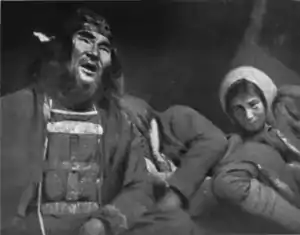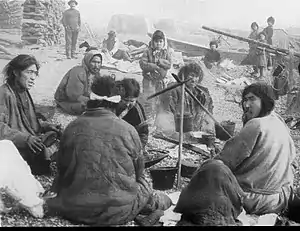凯特人
凯特人(俄語:,英語:),是居住在西伯利亚的一支操凯特语的民族。在沙皇俄国时期,被称作“奥斯蒂亚克人(汉特人)”,并未从其它西伯利亚民族中区分出来。随后,又被称作“叶尼塞-奥斯蒂亚克人”,因其居住在叶尼塞河的中下游地区。现在,凯特人居住于叶尼塞河的中东部地区。
| 凯特人 Кеты | |
|---|---|
 萨满,1914年 | |
| 總人口 | |
| 1494 | |
| 分佈地區 | |
| 語言 | |
| 凯特语、俄语 | |
| 宗教信仰 | |
| 薩滿教 |


历史
凯特人据称是西伯利亚中南地区古代游牧民族的遗民。今天的凯特人是叶尼塞林区渔猎民族的后代,他们继承了西伯利亚南部地区凯特族的文化。早期的部落从事渔猎活动,并饲养驯鹿。加拿大学者蒲立本推测凯特人和古代匈奴或胡羯民族有关。根据传说,凯特人的祖先为了躲避“石人”(Tystad)的侵袭,于两千年前翻越阿尔泰山和萨彦岭沿着叶尼塞河迁徙而来。到达叶尼塞河中游一带,又受到了“契里契”(Kiliki)人的攻击,被迫再次北逃。叶尼塞河下游地区的凯特人自称尤克人,尤克一词在爱斯基摩语中意为“人类”。
凯特人地区于17世纪并入沙俄。凯特人的反抗最终无效,并被逐入分散的地区。原本组织严密的父系社会因此逐渐瓦解。
20世纪,苏联在此推行农业集体化。1930年代,苏联实行原住民族民族自定族属政策时,凯特人的民族地位得到承认。
凯特族人口自1923年至今相对稳定。根据2002年人口普查结果,俄国境内现有1494人,而1970年时为1200人。今天,凯特人居住于沿河的小城镇中,不再从事游牧。
语言
凯特语与西伯利亚其它语言迥然不同,却与北美的德內-葉尼塞語門的納-達尼語系(阿萨巴斯卡語支)关系密切。“凯特”一词本意为“人”(复数“deng”:“众人,人民”)。 卡斯河、斯姆河、杜布齐河沿岸的凯特人自称为“朱衮”[JUGUN]。1788年,P.S. 帕拉斯在其旅行日记中首次发表了关于凯特语的调查报告。
1926年,曾有1428名凯特人,其中1225人(约占85.8%)使用凯特语。1989年人口普查表明,凯特语的使用者只剩537人(约占48.3%)。
宗教
1930年代前,萨满教曾是传统宗教,但到1960年代几乎无法找出真正的萨满。
脚注
參考文獻
- Alekseyenko, E. A. . Diószegi, Vilmos; Hoppál, Mihály (编). . Budapest: Akadémiai Kiadó. 1978.
- Diószegi, Vilmos. . Budapest: Magvető Könyvkiadó. 1960 [2016-09-06]. (原始内容存档于2016-10-22) (匈牙利语). The book has been translated to English: Diószegi, Vilmos. . Translated from Hungarian by Anita Rajkay Babó. Oosterhout: Anthropological Publications. 1968.
- Hoppál, Mihály. . Budapest: Helikon Kiadó. 1994. ISBN 963-208-298-2 (匈牙利语). The title means “Shamans, souls and symbols”.
- Hoppál, Mihály. . Budapest: Akadémiai Kiadó. 2005. ISBN 963-05-8295-3 (匈牙利语). The title means “Shamans in Eurasia”, the book is written in Hungarian, but it is published also in German, Estonian and Finnish. Site of publisher with short description on the book (in Hungarian)页面存档备份,存于
- Ivanov, Vyacheslav; Vladimir Toporov. . Semiotica (The Hague • Prague • New York: Mouton). 1973, IX (4): 318–346.
- Ivanov, Vjacseszlav (=Vyacheslav). . . Collected, appendix, editorial afterword by Hoppál, Mihály. Budapest: Gondolat. 1984. ISBN 963-281-186-0 (匈牙利语). The title means: “Language, myth, culture”, the editorial afterword means: “Languages and mythologies”.
- Ivanov, Vjacseszlav (=Vyacheslav). . . Collected, appendix, editorial afterword by Hoppál, Mihály. Budapest: Gondolat. 1984: 215–233. ISBN 963-281-186-0 (匈牙利语). The title means: “Language, myth, culture”, the chapter means: “Obi-Ugric and Ket folklore contacts”.
- Middendorff, A. Th., von. . Tallinn. 1987.
- Paulson, Ivar. . Gulya, János (编). . Budapest: Európa Könyvkiadó. 1975: 283–298. ISBN 963-07-0414-5 (匈牙利语). Chapter means: “The world view and the nature in the religion of the North-Siberian peoples”; title means: “The people of water fowls. Studies on lifes and cultures of the Finno-Ugric relative peoples”.
- Zolotarjov, A.M. . Hoppál, Mihály (编). . Budapest: Európa Könyvkiadó. 1980: 29–58. ISBN 963-07-2187-2 (匈牙利语). Chapter means: “Social structure and dualistic creation myths in Siberia”; title means: “The sons of Milky Way. Studies on the belief systems of Finno-Ugric peoples”.
外部連結
| 维基共享资源中相关的多媒体资源:凯特人 |
- Professor Ed Vajda talking about the importance of the Ket and their language, plus a short story told by a Ket speaker.
- . The Red Book of the Peoples of the Russian Empire. [2016-09-06]. (原始内容存档于2016-06-11).
- Edward J, Vajda. . [2016-09-06]. (原始内容存档于2019-04-06).
- Ethnologue on Ket页面存档备份,存于
- Ket Language
- Endangered Languages of the Indigenious Peoples of Siberia - The Ket Language
- Yeniseian Peoples and Languages页面存档备份,存于
- The Ket People - Google Video - 404 error
- Starostin S.A.
- Multimedia Database of Ket, Documentation of Endangered Languages at Laboratory for Computer Lexicography Lomonosov Moscow State University.
- Ket texts页面存档备份,存于, a Ket tale "Balna" in original + in Russian and English, with linguistic annotation.
- Pavel Flegontov, Piya Changmai, Anastassiya Zidkova, Maria D. Logacheva, Olga Flegontova, Mikhail S. Gelfand, Evgeny S. Gerasimov, Ekaterina V. Khrameeva, Olga P. Konovalova, Tatiana Neretina, Yuri V. Nikolsky, George Starostin, Vita V. Stepanova, Igor V. Travinsky, Martin Tříska, Petr Tříska, Tatiana V. Tatarinova: Genomic study of the Ket: a Paleo-Eskimo-related ethnic group with significant ancient North Eurasian ancestry页面存档备份,存于